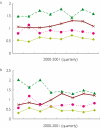Effects of licence change on prescribing and poisons enquiries for antipsychotic agents in England and Scotland
- PMID: 12814455
- PMCID: PMC1884257
- DOI: 10.1046/j.1365-2125.2003.01792.x
Effects of licence change on prescribing and poisons enquiries for antipsychotic agents in England and Scotland
Abstract
Aims: To examine the effect of licence change for thioridazine at the end of 2000 on the prescription of antipsychotic drugs in England and Scotland, and investigate changes in poisons information inquiries and, for Edinburgh, poisons admissions.
Methods: Prescription data for antipsychotic drugs were obtained for England and Scotland and quarterly trends examined for 2000 and 2001. Accesses to the UK National Poisons Information Service website TOXBASE for antipsychotic products were examined for the same period. For Scotland telephone enquiry data, and admission data to the Edinburgh Poisons Unit were also evaluated. Trends in poisonings were compared with prescribing change.
Results: In England prescriptions for thioridazine fell rapidly in 2001 from approximately 35% of market share to less than 5%, and were replaced by risperidone, chlorpromazine and olanzapine. TOXBASE accesses fell from 39.3% of antipsychotics to 4.4%. Accesses for chlorpromazine, olanzapine and risperidone increased. In Scotland prescribing of thioridazine was similar to changes in England, but it was principally replaced by chlorpromazine. These changes were mirrored by TOXBASE accesses, telephone enquiries and in-patient admissions. The ratio of TOXBASE accesses for thioridazine to prescription numbers for the drug increased after the licence change.
Conclusions: Licence change produced rapid change in prescribing behaviour within 3 months. Prescribing behaviour in England and Scotland was different. Changes in prescribing were mirrored by changes in accesses for poisons information in both England and Scotland, and in Edinburgh by hospital admissions. The increase in the ratio of TOXBASE accesses to prescriptions for thioridazine suggests doctors may have become more aware of its potential toxicity.
Figures

 , Others;
, Others;  , risperidone/olanzapine;
, risperidone/olanzapine;  , chlorpromazine; ×, thioridazine. b, Percentage Scotland.
, chlorpromazine; ×, thioridazine. b, Percentage Scotland.  , Risperidone/olanzapine;
, Risperidone/olanzapine;  , others;
, others;  , chlorpromazine; ×, thioridazine. (Others – haloperidol, sulpiride, risperidone + 18 other antipsychotics – see text.)
, chlorpromazine; ×, thioridazine. (Others – haloperidol, sulpiride, risperidone + 18 other antipsychotics – see text.)
 , Chlorpromazine; ×, thioridazine;
, Chlorpromazine; ×, thioridazine;  , olanzapine;
, olanzapine;  , risperidone. (Others – haloperidol, sulpiride, risperidone + 18 other antipsychotics – see text.)
, risperidone. (Others – haloperidol, sulpiride, risperidone + 18 other antipsychotics – see text.)References
-
- Fowler NO, McCall D, Chou TC, Holmes JC, Hanenson IB. Electrocardiographic changes and cardiac arrhythmias in patients receiving psychotropic drugs. Am J Cardiol. 1976;37:223–230. - PubMed
-
- Gottschalk LA, Dinovo E, Biener R, Nandi BR. Plasma concentrations of thioridazine metabolites and ECG abnormalities. J Pharm Sci. 1978;67:155–157. - PubMed
-
- Hine B, Traficante LJ, Sakalis G, Gershon S. Thioridazine and EKG abnormalities. Experientia. 1979;35:1631–1632. - PubMed
-
- Buckley NA, Whyte IM, Dawson AH. Cardiotoxicity more common in thioridazine overdose than with other neuroleptics. J Toxicol Clin Toxicol. 1996;34:127–130. - PubMed
MeSH terms
Substances
LinkOut - more resources
Full Text Sources

